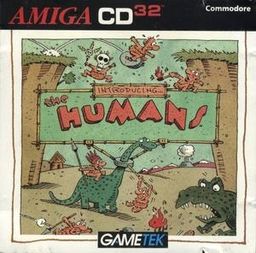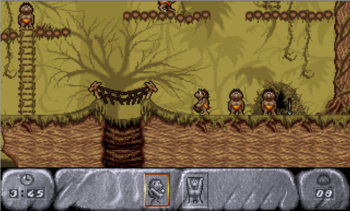- The Humans
-
The Humans 
Amiga CD32 cover artDeveloper(s) Imagitec Design[1] Publisher(s) GameTek[1] Designer(s) Rod Humble Platform(s) Mega Drive/Genesis, Super NES, Game Boy, Amiga, Amiga CD32, 3DO, PC, Jaguar, Lynx, Atari Falcon, Nintendo DS Release date(s) 1992[1] Genre(s) Puzzle Mode(s) Single player The Humans is a puzzle game published and released by GameTek in 1992. The goal of The Humans varies per level, but is usually to bring at least one of the player-controlled humans to the designated end area, marked by a red tile. To do this, the player must take advantage of the humans' ability to build a human ladder and use tools, such as spears, torches, wheels, ropes, in later levels, a witch doctor.[1]
The Humans was released for many different consoles, with the Jaguar and Lynx versions, published by Atari, titled Evolution: Dino Dudes and Dinolympics respectively.[2] Two sequels have been released, "The Humans 2: The Jurassic Levels" for Amiga and PC and "The Humans III: Evolution- Lost in Time" for Amiga and PC.[3] In 2009, it was rereleased for Windows under the name "The Humans: Meet the Ancestors!"[4] Upon its release, The Humans was received very well, praised for its originality and decent graphics and music.[5]
Contents
Gameplay
The Humans is a puzzle game whose objective is to manipulate the given number of humans, taking advantage of abilities and tools, to achieve the level's goal, usually consisting of finding a certain tool, killing a certain number of dinosaurs, or bringing at least one human to the end point, marked by a conspicuous red tile. Each level is independent of the next, each with its own tools, goal, and set number of humans allowed per level. The only things that carry from level to level are the total number of humans in the player's tribe and the player's total score.[6]
The player controls one human at a time, and may switch between any human at any time. In order to complete a level, it is often necessary to use certain tools or abilities, such as stacking to reach a high ledge. For instance, the spear, a tool obtained in the first level of the game, may be thrown across gaps to other humans, used to jump chasms, thrown to kill dinosaurs or other enemies, or brandished hold off dinosaurs temporarily. Certain levels also feature npcs, like the pterodactyl that can be ridden in order to reach otherwise unreachable platforms, that cannot be controlled, but can be used to the player's advantage. Several forms of enemy appear and can range from dinosaurs that eat a human if he is unarmed and within its walking range to spear-wielding members of enemy tribes.[6]
There can be up to eight controllable humans in a level, though some levels only allow as few as three. Though there is a preset number of humans allowed per level, there is no limit to how many humans are in the player's tribe. If a human dies, he is replaced by one from the tribe as long as there are humans there to replace him. During the course of the game, the player is given chances to rescue other humans and add them to his tribe. If there are fewer humans in the player's tribe than the minimum required number for any given level, the game will end in a game over. Each level, however, has a password that can be used to jump to that particular level from the beginning of the game.[6]
Development
The Humans is modeled after Psygnosis's Lemmings series of games in that it is a timed puzzle game that requires the player to make each individual perform different tasks to achieve one goal, but differs in that it gives direct control of individual humans to the player, rather than only allowing the player to simply assign tasks. GameTek released this game in 1992, shortly after The Lemmings was released hoping to capitalize the popularity of this style of game. The Humans also derives its pre-game screen, featuring a code that may be used to reach that particular level, used by both The Lemmings as well as Populous.[7]
Known commercial ports of the original game include: 3DO, Amiga CD32, Gameboy, Genesis, and PC.[3] The Genesis version differs slightly from the other versions of this game differs in that the 80 levels of the game are in a different order than in the Amiga and PC versions. In addition, the Genesis version requires the player to choose between hearing sound effects or a music track, unlike the PC and Amiga versions, which utilize both simultaneously.[citation needed]
Following the success of the original release, an expansion pack containing 80 additional levels was released in 1992 under the name "Humans 2: The Jurassic Levels"in the UK and "The Humans: Insult to Injury" in the US. in 1993, the two games were combined and released for both Amiga and DOS under the name "Humans 1 and 2"[8] and included English, French, German, Italian and Spanish versions. The DOS was distributed on a CD-ROM and was improved in several ways, including adding a save game feature so the player could quit, then restart at a later time. In 1995, GameTek released The Humans 3: Evolution- Lost in Time for Amiga and DOS. The third installment keeps to the original game idea, but differs from the original in storyline, gameplay style, and level continuity.[9]
About a decade after GameTek declared bankruptcy, The Humans was upgraded and rereleased by Deep Silver for Windows under the name "The Humans: Meet the Ancestors".[4] This version kept the same general gameplay style, but improved the graphics and added more interactive objects and enemies.[10]
Reception
Reception Review scores Publication Score Amiga Mania Amiga: 93 out of 100[5] Abandonia PC: 4.0 out of 5[1] Allgame PC: 



 [7]
[7]MobyGames Gameboy: 2.9 out of 5[2]
Lynx: 2.6 out of 5[2]The Amiga and PC versions of The Humans received excellent reviews, while those of versions ported to other consoles were more lukewarm. Ashley Cotter-Cairn, of Amiga Mania, gave the Amiga version an overall score of 93% and ranked it number 1 claiming "The Humans has everything: great graphics, including a variety of backdrops, some neat sound...(she's) pleased to say that those long months at the keyboard ware worth every second."[5]
References
- ^ a b c d e "Humans, The". Abandonia. http://www.abandonia.com/en/games/337/Humans%2C+The.html. Retrieved 2011-05-12.
- ^ a b c "The Humans". MobyGames. http://www.mobygames.com/game/humans. Retrieved 2011-05-14.
- ^ a b "Gametek". IGN. http://games.ign.com/objects/025/025030.html. Retrieved 2011-05-14.
- ^ a b "The Humans: Meet the Ancestors!". MobyGames. http://www.mobygames.com/game/humans-meet-the-ancestors. Retrieved 2011-05-15.
- ^ a b c Cotter-Cairn, Ashley (1993). "The Humans Review". Amiga Mania (Mirage) 7 (4). http://amr.abime.net/review_3618. Retrieved 2011-05-16.
- ^ a b c The Humans Instruction Manual for Sega Genesis. GameTek. 1992. pp. 26. http://www.replacementdocs.com/request.php?7401. Retrieved 2011-05-14.
- ^ a b "The Humans". Allgame. http://www.allgame.com/game.php?id=15555. Retrieved 2011-05-14.
- ^ "Humans 1 and 2". MobyGames. http://www.mobygames.com/game/humans-1-and-2. Retrieved 2011-05-15.
- ^ "The Humans 3: Evolution- Lost in Time". MobyGames. http://www.mobygames.com/game/humans-3-evolution-lost-in-time. Retrieved 2011-05-15.
- ^ "Dinosaur Games: The Humans Meet the Ancestors- Windows PC". Dinosaur Games. 2011-03-26. http://dinosaurgames.gamesw.org/2011/03/26/dinosaur-games-the-humans-meet-the-ancestors-windows-pc/. Retrieved 2011-05-15.
External links
- The Humans series at MobyGames
- The Humans at Allgame
- The Humans at Abandonia
- The Humans at Lemon Amiga
Categories:- 1992 video games
- 3DO games
- Amiga games
- CD32 games
- DOS games
- Game Boy games
- Imagitec Design games
- Puzzle video games
- Sega Mega Drive games
- Super Nintendo Entertainment System games
Wikimedia Foundation. 2010.

